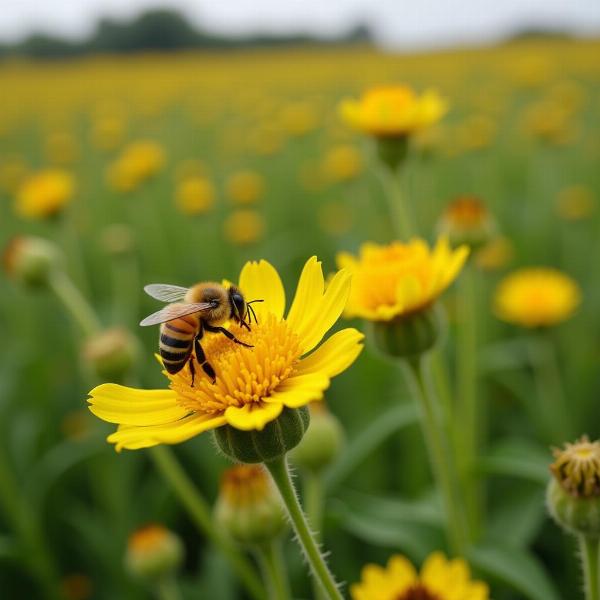Xenogamy, a crucial concept in botany and agriculture, refers to cross-pollination. Understanding its meaning in Hindi, along with its implications, is essential for anyone involved in plant cultivation or studying plant biology. This article delves deep into the xenogamy meaning in Hindi, exploring its significance, benefits, and various aspects.
What Does Xenogamy Mean in Hindi?
Xenogamy, known as परनिषेचन (parniṣecan) in Hindi, literally translates to “fertilization by another.” This term accurately captures the essence of xenogamy, where the pollen from one flower fertilizes the ovule of another flower, typically on a different plant of the same species. This process stands in contrast to self-pollination (स्व-परागण – sva-paragan) where fertilization occurs within the same flower or plant.
The Significance of Xenogamy in Plant Reproduction
Xenogamy plays a vital role in maintaining genetic diversity within plant populations. By facilitating the mixing of genetic material from different individuals, it leads to the creation of offspring with a wider range of traits. This diversity is crucial for the adaptation and survival of plant species, particularly in changing environmental conditions. It strengthens resistance to diseases, pests, and other environmental stressors.
Benefits of Xenogamy
Xenogamy offers several advantages over self-pollination. It results in healthier and more vigorous offspring, often exhibiting improved yield and quality. The introduction of new genetic combinations can lead to the development of desirable traits, such as increased fruit size, enhanced flavor, or improved resistance to diseases.
Different Types of Xenogamy and Their Mechanisms
Xenogamy can occur through various mechanisms, often facilitated by external agents like wind, water, insects, birds, or other animals. These agents carry pollen from one flower to another, ensuring cross-pollination. Understanding these mechanisms is crucial for optimizing pollination strategies in agriculture and horticulture.
How does wind facilitate xenogamy?
Wind-pollinated flowers are typically small and inconspicuous, producing large quantities of lightweight pollen that can be easily carried by the wind.
What is the role of insects in xenogamy?
Insect-pollinated flowers often have bright colors, attractive scents, and nectar to attract insects. The pollen grains are often sticky, adhering to the insects as they visit the flowers.
Xenogamy and its Impact on Agriculture
Xenogamy is a fundamental concept in agriculture, especially in the cultivation of crops that rely on cross-pollination for fruit and seed production. Farmers often employ various techniques to promote xenogamy, such as planting different varieties of the same species in close proximity or introducing pollinators like bees to their fields.
 Xenogamy in Agriculture Example
Xenogamy in Agriculture Example
Conclusion
Understanding xenogamy meaning in Hindi, i.e., परनिषेचन (parniṣecan), is crucial for comprehending the intricacies of plant reproduction and its implications in agriculture and biodiversity. By promoting genetic diversity and enhancing plant vigor, xenogamy plays a vital role in the survival and evolution of plant species.
FAQ
- What is the difference between xenogamy and geitonogamy? Geitonogamy involves pollen transfer between flowers on the same plant, while xenogamy involves pollen transfer between flowers on different plants of the same species.
- Why is xenogamy important for evolution? Xenogamy promotes genetic variation, providing the raw material for natural selection and driving evolutionary change.
- How can farmers promote xenogamy in their crops? Farmers can promote xenogamy through techniques like intercropping, introducing pollinators, and hand-pollination.
- What are some examples of xenogamous plants? Many fruit trees, vegetables, and ornamental plants are xenogamous, including apples, mangoes, and sunflowers.
- What is the Hindi word for self-pollination? The Hindi word for self-pollination is स्व-परागण (sva-paragan).
- How does xenogamy contribute to biodiversity? By fostering genetic diversity, xenogamy ensures the existence of a wider range of plant species and varieties.
- What are the disadvantages of xenogamy? Xenogamy can be less reliable than self-pollination, especially in environments where pollinators are scarce or environmental conditions are unfavorable.
Meaning-Hindi.in is your trusted partner for professional Hindi translation services. We offer a wide range of translation solutions, including business and commercial document translation, certified and legal document translation, technical and user manual translation, website and localization translation, educational and academic document translation, express translation, and specialized translation services. Our team of expert Hindi linguists and subject matter experts is dedicated to providing accurate and culturally sensitive translations that meet your specific needs. Contact us today for a free quote! Email: [email protected], Phone: +91 11-4502-7584. Meaning-Hindi.in is your one-stop solution for all your Hindi translation requirements.